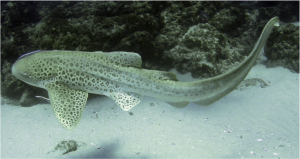At the MFL, we are keen to develop genetic methods for assessing abundance of fisheries populations. One method being explored is genetic effective population size. We are focusing on shark and ray populations, because they are generally less abundant than species like finfish and shellfish and the math is easier.
A new study that was published today trials this method on leopard sharks. Christine Dudgeon and Jenny Ovenden found that genetic and conventional estimates of the numbers of adults in an aggregation off the coast of south-east Queensland were similar. This is one of very few studies worldwide that have been able to make this type of comparison. Its important it demonstrates how abundance can be inferred from DNA. Assuming tissue samples are available, the DNA method is quick and easy compared to tagging sharks and observing their occurrence over the years as a way of estimating abundance. Species can be more adequately protected when estimates of abundance are available.
Email Christine Dudgeon (c.dudgeon at uq.edu.au, where at = @) for a copy of the paper.
To find out more about Christine’s leopard shark project in Thailand, click here.

